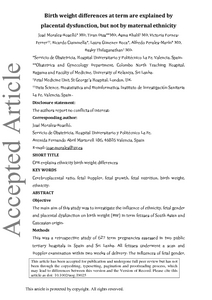Morales-Roselló, J; Dias, T; Khalil, A; Fornes-Ferrer, V; Ciammella, R; Gimenez Roca, L; Perales-Marín, A; Thilaganathan, B
(2018)
Birth‐weight differences at term are explained by placental dysfunction and not by maternal ethnicity.
Ultrasound Obstet Gynecol, 52 (4).
pp. 488-493.
ISSN 1469-0705
https://doi.org/10.1002/uog.19025
SGUL Authors: Khalil, Asma
![[img]](https://openaccess.sgul.ac.uk/109609/1.hassmallThumbnailVersion/Morales-Rosell-_et_al-2018-Ultrasound_in_Obstetrics_%26_Gynecology.pdf)  Preview |
|
PDF
Accepted Version
Available under License ["licenses_description_publisher" not defined].
Download (1MB)
| Preview
|
Abstract
Objective
To investigate the influence of ethnicity, fetal gender and placental dysfunction on birth weight (BW) in term fetuses of South Asian and Caucasian origin.
Methods
This was a retrospective study of 627 term pregnancies assessed at two public tertiary hospitals in Spain and Sri Lanka. All fetuses underwent biometry and Doppler examinations within 2 weeks of delivery. The influences of fetal gender and ethnicity, gestational age (GA) at delivery, cerebroplacental ratio (CPR) and maternal age, height, weight and parity on BW were evaluated by multivariable regression analysis.
Results
Fetuses born in Sri Lanka were smaller than those born in Spain (mean BW = 3026 ± 449 g vs 3295 ± 444 g; P < 0.001). Multivariable regression analysis demonstrated that GA at delivery, maternal weight, CPR, maternal height and fetal gender (estimates = 0.168, P < 0.001; 0.006, P < 0.001; 0.092, P = 0.003; 0.009, P = 0.002; 0.081, P = 0.01, respectively) were associated significantly with BW. Conversely, no significant association was noted for maternal ethnicity, age or parity (estimates = −0.010, P = 0.831; 0.005, P = 0.127; 0.035, P = 0.086, respectively). The findings were unchanged when the analysis was repeated using INTERGROWTH‐21st fetal weight centiles instead of BW (log odds, −0.175, P = 0.170 and 0.321, P < 0.001, respectively for ethnicity and CPR).
Conclusion
Fetal BW variation at term is less dependent on ethnic origin and better explained by placental dysfunction.
Copyright © 2018 ISUOG. Published by John Wiley & Sons Ltd.
| Item Type: |
Article
|
| Additional Information: |
This is the peer reviewed version of the following article: Morales‐Roselló, J. , Dias, T. , Khalil, A. , Fornes‐Ferrer, V. , Ciammella, R. , Gimenez‐Roca, L. , Perales‐Marín, A. and Thilaganathan, B. (2018), Birth‐weight differences at term are explained by placental dysfunction and not by maternal ethnicity. Ultrasound Obstet Gynecol, 52: 488-493, which has been published in final form at https://doi.org/10.1002/uog.19025. This article may be used for non-commercial purposes in accordance with Wiley Terms and Conditions for Self-Archiving. |
| Keywords: |
Cerebroplacental ratio, birth weight, ethnicity, fetal Doppler, fetal growth, fetal nutrition, Obstetrics & Reproductive Medicine, 1114 Paediatrics And Reproductive Medicine |
| SGUL Research Institute / Research Centre: |
Academic Structure > Molecular and Clinical Sciences Research Institute (MCS) |
| Journal or Publication Title: |
Ultrasound Obstet Gynecol |
| ISSN: |
1469-0705 |
| Language: |
eng |
| Dates: |
| Date | Event |
|---|
| 4 October 2018 | Published | | 23 August 2018 | Published Online | | 26 January 2018 | Accepted |
|
| Publisher License: |
Publisher's own licence |
| PubMed ID: |
29418032 |
 |
Go to PubMed abstract |
| URI: |
https://openaccess.sgul.ac.uk/id/eprint/109609 |
| Publisher's version: |
https://doi.org/10.1002/uog.19025 |
Statistics
Item downloaded times since 13 Feb 2018.
Actions (login required)
 |
Edit Item |



